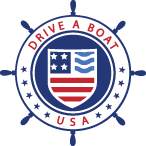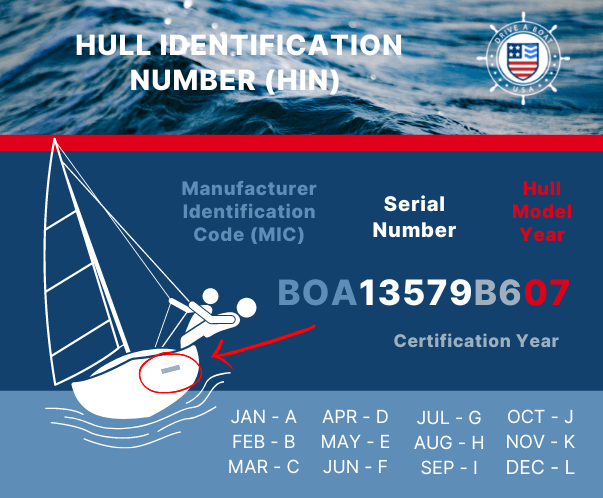Boat Hull Identification Numbers (HIN)
Hull Identification Numbers (HIN) are permanent markings used to identify every boat manufactured in or imported to the United States since 1972.
A HIN is made up of 12 characters including numbers and letters. Each HIN is unique. A HIN include the boat’s serial number, as well as other indicators.
It is illegal to alter or remove a HIN without the express written authorization of the Commandant, U.S. Coast Guard, regardless of whether you are the boat manufacturer, dealer, distributor, or owner.
What are HINs useful for?
A boat’s Hull Identification Number is used to register a boat and track its history.
For boat owners, a HIN is particularly helpful if you are buying a used boat, as it allows you to correctly identify the month and year of its manufacture, helping protect you from fraudulent claims by the seller. It is also used to recover stolen vessels.
For boat manufacturers, the HIN is used to identify boats that are subject to recalls.
For the government, the HIN has several further uses, including registration and titling, documentation (United States Coast Guard) and national security (Dept. of Homeland Security).
You should take a rubbing and/or write down the HIN of your boat and keep it in a safe place away from your vessel. You should also note it in insurance documents, the boat title and your boat registration.
Even if you build your own boat for your own personal, non-commercial use, you still need to acquire the correct State Assigned hull identification and affix it permanently to your boat. Drive A Boat USA can help you learn more about boating laws and safety in your specific state.
Where is the HIN located on my boat?
Your boat’s HIN is either engraved, burned, stamped, embossed, molded or bonded directly onto your boat, or indicated on a plate attached to your boat. The HIN must be impossible to remove or change without leaving traces.
A HIN is usually found at the stern of the boat, on the starboard side of the transom or in that general area. If the boat has no transom, or it is blocked by a swim platform, it can be on the uppermost starboard side of the hull at the stern. It should be easily visible while out on the water.
Since 1984, there must also be a duplicate HIN placed in an unexposed part of the boat, either in the interior or beneath a part of the boat’s hardware. The characters of each HIN must be at least ¼ inch tall.
If you’re not sure where to look for the HIN, take a moment to review the parts of a boat.
Reasons why a boat doesn’t have a Hull Identification Number
Boats built before 1972 did not legally require a HIN. If you have an old boat, you can apply a new HIN from the USCG.
If your boat is newer and the HIN has been removed or gone missing, or the format is out of date, you can also apply for a new one.
Note that if an old HIN is still attached to your boat and you apply for a new one in the up-to-date format, you have to attach the new HIN above the old one so that both are visible.
What is the format of a HIN?
A HIN is made up of 12 characters, including both numbers and letters. Here is a breakdown of what these characters indicate in the Current Format. Note that boats built before 1984 may have HINs that follow the Straight Year Format or Model Year Format. If you aren’t sure, check the USCG Validation & Verification Guidelines.
Sample HIN: BOA13579B607
The first three letters (BOA): This is the Manufacturer Identification Code (MIC) assigned by the U.S. Coast Guard. To find out what it stands for, visit the USCG Manufacturers Identification page.
The next 5 numbers and/or letters (13579): This is the serial number. It is assigned to the hull by the manufacturer. Note that the letters I, O, and Q are never used because they could be mistaken for numbers.
The next letter (B): This indicates the month in which the boat was certified. The letters do not match the first letters of the names of the month – for example, A represents January and L represents December. In our example, B means February.
JAN A
FEB B
MAR C
APR D
MAY E
JUN F
JUL G
AUG H
SEP I
OCT J
NOV K
DEC L
The next number (6): This is the year of certification. The number is the last digit of the year in which the boat was built. Since this can cause some confusion, please see the explanation below.
The final two digits (07): This indicates year of the hull model.
Is my Hull Identification Number valid?
Note that the date indicated on a HIN may not reflect the exact date of manufacturing. A HIN is assigned and reflects the date on which the boat was certified by the builder to meet Coast Guard regulations.
Also, there were several HIN formats before 1984. In your boat is older, the letters representing the month may differ. It is no longer legal to use the old date formats, but some older boats may still have them.
There can also be confusion around the certification date and the model year date. A boat can appear to have a certification date that is older than the model date, but this does not necessarily indicate fraud. Assembling a boat can take several years, and in addition, hull designs may not change from year to year. The certification date can be no earlier than the date on which construction or assembly began, and no later than the date when the boat leaves the manufacturing or assembly location or is imported for sale.
The certification date is more important to the USCG than the model date to determine compliance with standards. Boat manufacturers are permitted to determine the model year with some leeway.
What types of boat need a HIN?
All types of boats manufactured, sold or imported to the US require a HIN.
Learn more about boating laws with Drive a Boat USA
The HIN on your boat is a unique identifier that is used for many things, including safety verification, tracking and documentation.
Drive A Boat USA can help you learn about boating rules and regulations specific to your state. Contact us today to get your official state-approved online boating license and take to the water with confidence!


